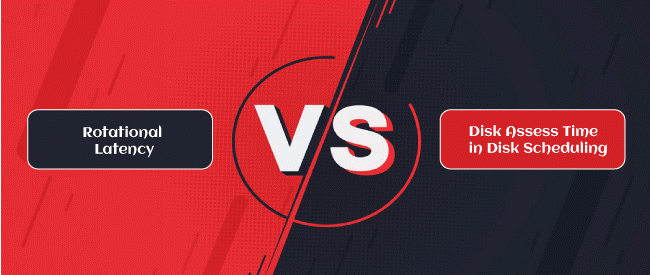Difference between Rotational Latency and Disk Assess Time in Disk Scheduling
Disk scheduling is used by operating systems to arrange the arrival of I/O requests to the disc. Disk scheduling is necessary because several I/O requests may occur from various processes, and the disc controller can only service one I/O request at a time. As a result, further I/O requests must wait in the queue and be scheduled. The phrases seek time, rotational latency, transfer time, and disc access time are all essential.

The time it takes for the read/write head of a hard drive to detect the physical position of a piece of data on the disk is known as seek time. After a complete search, the average time it takes for the sector to move to the next location is called latency.
Rotational Latency
The disc is split into several circular tracks, which are further subdivided into chunks called sectors. The read-write head is moved by the actuator arm to a specific track above the plate as the platter rotates to place the specified sector under the read-write head. Rotational latency is the time it takes to rotate the platter and keep the data under the read-write header. This delay is measured in milliseconds and is determined by the rotational speed of the spindle. The average rotational delay of a disc is half of the time it takes for the disc to complete one revolution. This delay is measured in milliseconds and is determined by the rotational speed of the spindle. The average rotational delay of a disc is half of the time it takes for the disc to complete one revolution.
The rotating speed of a disc or spindle motor, measured in revolutions per minute, determines the rotational latency time (RPM). The average rotational latency for most magnetic media-based drives is usually based on the empirical relation that the average delay in milliseconds for such drives is half of the rotational period. The two types of disc rotation techniques are as follows:
- Constant linear velocity (CLV), used mostly in optical storage, varies the rotational speed of the optical disc depending on the position of the he
- Constant angular velocity (CAV), used in most HDDs, standard FDD, some optical disc systems and vinyl audio records, rotates the media at a constant speed, regardless of where the head is locate
Disk Access Time
The overall time taken by the computer to perform a read/write request and then obtain the relevant data from disc storage is known as disc access time. Disk access time is divided into two halves. The first factor is search time, which is the time it takes for the read and write arm to locate the required track. Latency, or wait time, is the time it takes for the head write arm to wait for the required sector on the track to rotate around. The time it takes to access data on drives is measured in milliseconds. This is, however, far slower than CPU processing rates. Although I/O is still sluggish, it cannot keep up with the advances in CPU performance. There are two elements to the disc access time:
- Data Transfer Time
- Access Time
Access Time
The preparation time before the actual data transfer is represented as the access time. For example, the read/write head is on track 1, but we need to read data from a different track or segment. As a result, before the actual transfer, the read/write head will relocate to the data block position. This lag is referred to as Access Time. The following factors are added together to determine access time:
Seek Time
The time it takes the read/write head to reach the intended output is called seek time. It is recognized as the most crucial period since it cannot be missed. The amount of time it takes to find something is inversely related to the amount of time it takes to find it. The better the performance, the shorter the seek time.
Main Difference
|
S no. |
Rotational Latency |
Disk Access |
|
1. |
Rotational Latency = Intersection of the present and necessary sectors / Rotational frequency. |
Disk Access =Time spent seeking + rotational latency + time spent transferring data. |
|
2. |
Because the exact physical position of blocks is not accessible in most current systems, most disc scheduling does not include rotational frequency. |
In comparison to Seek time, it is rather enormous. |
|
3. |
The spindle's rotating speed determines rotational latency. |
The two components of disk access time are access time and data transfer time. |
|
4. |
If a later request comes from a neighbouring sector, rotational latency can be minimised. |
If we can reduce the access time and data transfer time, we can reduce the disk access time. |